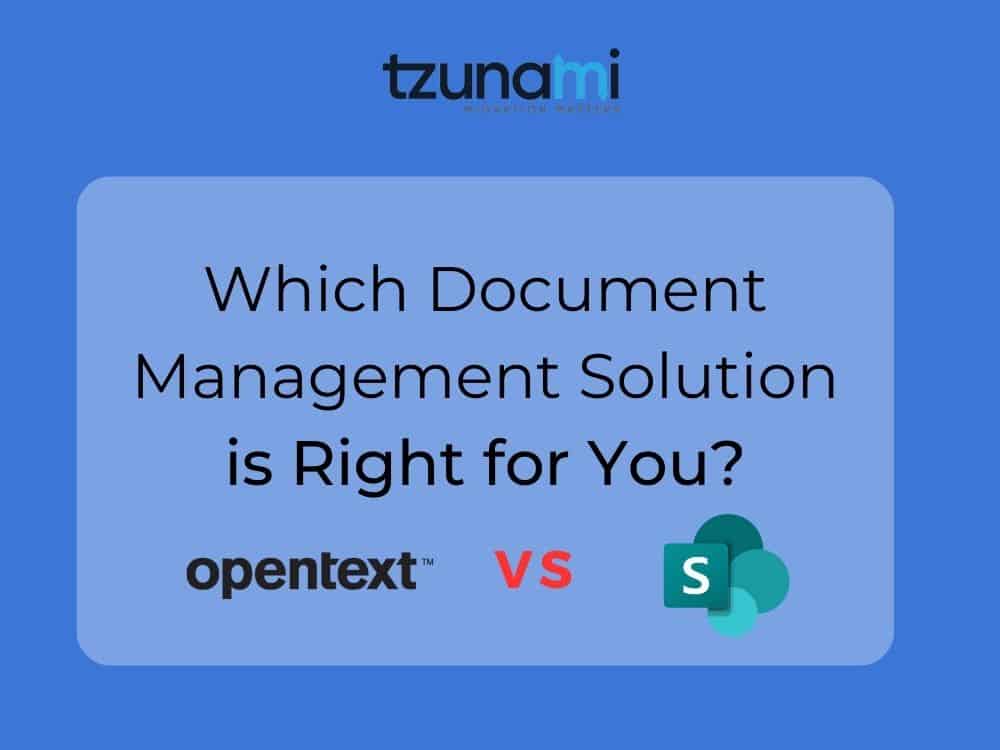- SharePoint Migration services
- Supported Systems
ECM
MenuSharePoint
MenuCloud
Menu - Features
- Clients
- Partners
- Blog
- Contact Us
OpenText VS SharePoint
Home » OpenText VS SharePoint
- October 16, 2023
OpenText VS SharePoint: Which Document Management Solution is Right for You?
In today’s fast-paced business environment, efficient document management is critical. Organizations rely on document management systems to streamline operations, improve collaboration, and enhance data security. However, choosing the right document management solution is no easy task. This article aims to help you make an informed decision by comparing two prominent options: OpenText and SharePoint.
Overview of OpenText
OpenText is a leading document management system with a rich history dating back to 1991. It has evolved into a comprehensive Enterprise Information Management (EIM) platform, offering solutions for document management, records management, and more.
- OpenText’s journey started as a search engine technology company and has since expanded its offerings through acquisitions and innovations.
- OpenText boasts features like document version control, workflow automation, and robust search capabilities. It excels in managing complex documents and records.
- OpenText is commonly used in industries such as healthcare, legal, and manufacturing, where document-intensive processes demand rigorous compliance and security.
Overview of SharePoint
SharePoint is a collaboration and document management platform developed by Microsoft. It was first introduced in 2001 and has since become an integral part of the Microsoft 365 suite.
- Initially, SharePoint focused on collaboration and Internet Over time, it has grown to include advanced document management capabilities.
- SharePoint offers features like document libraries, co-authoring, and integration with Microsoft apps. Its strength lies in its seamless integration with the Microsoft ecosystem.
- SharePoint is widely adopted across various industries, from small businesses to large enterprises, thanks to its versatility and integration with Microsoft tools.
Key Comparative Factors
To determine which platform is better suited to your organization’s needs, it’s essential to consider key comparative factors:
1. Integration:
Integration is a critical aspect to consider when evaluating document management solutions like OpenText and SharePoint. SharePoint boasts seamless integration with the broader Microsoft ecosystem, facilitating smooth collaboration with tools like Office 365 and Teams. This tight integration can be a compelling factor for organizations already invested in Microsoft’s suite of products. In contrast, OpenText prides itself on its ability to integrate with a wide array of third-party applications and systems, providing greater flexibility for organizations with diverse software needs. The choice between the two platforms may ultimately hinge on how much your organization relies on Microsoft products versus its need for a more versatile, cross-platform solution.
2. Scalability:
Scalability is a critical factor when evaluating document management solutions like OpenText and SharePoint. Both platforms offer the ability to grow with your organization, but the degree of scalability may differ. OpenText, known for its extensive customization and enterprise-level capabilities, is particularly well-suited for large organizations with complex information management needs. Its scalability options allow it to adapt seamlessly to evolving business demands. SharePoint, while also scalable, is often favored by small to medium-sized enterprises due to its straightforward implementation and integration with other Microsoft tools. Evaluating your organization’s long-term growth plans is crucial when deciding which platform’s scalability aligns best with your document management needs.
3. Collaboration:
SharePoint excels in this arena with its intuitive user interface and seamless integration with Microsoft Teams, creating an ecosystem that encourages efficient collaboration among team members. SharePoint’s document libraries, team sites, and workflow automation tools make it an ideal choice for organizations looking to enhance real-time collaboration and productivity. While OpenText also offers collaboration capabilities, it is often perceived as a more complex platform, potentially requiring a steeper learning curve for users. Therefore, organizations seeking a user-friendly and team-centric approach to collaboration may find SharePoint to be the more natural fit.
4. Document Management:
Both platforms offer robust document management features, but their approaches differ in terms of user experience and scalability. SharePoint, with its user-friendly interface and seamless integration with Microsoft Office 365, is an excellent choice for organizations looking to enhance team collaboration and document sharing. It excels in providing small to medium-sized businesses with intuitive document libraries and team sites. On the other hand, OpenText’s document management capabilities are comprehensive, offering extensive customization and advanced document management features. This makes OpenText an ideal choice for larger enterprises with complex compliance, regulatory, and information management requirements. When deciding between OpenText and SharePoint for document management, consider your organization’s size, collaboration needs, and the level of customization required to make an informed choice.
5. Compliance and Security
OpenText places a strong emphasis on compliance and security, making it an ideal choice for organizations operating in heavily regulated industries such as healthcare, finance, and government. Its comprehensive set of features and robust auditing capabilities ensure that organizations can meet stringent compliance requirements and protect sensitive data effectively. SharePoint, while also offering strong security measures and full compliance with industry standards, is particularly advantageous for organizations already entrenched in the Microsoft ecosystem. The decision here depends on the specific compliance and security demands of your organization and the extent of your reliance on Microsoft’s suite of tools.
6. Cost
SharePoint often stands out as the more cost-effective option, particularly for businesses and organizations already entrenched within the Microsoft ecosystem. Its bundled pricing and compatibility with Office 365 can offer significant savings. On the other hand, OpenText, while feature-rich and highly customizable, may entail a higher initial investment due to its extensive capabilities and the potential need for additional third-party integrations. Organizations should carefully evaluate their budget constraints and long-term cost projections to determine which solution aligns better with their financial resources and business objectives.
7. User Experience and User Adoption
SharePoint is known for its user-friendly interface and integration with widely used Microsoft applications, which can significantly boost user adoption within organizations already familiar with Microsoft’s ecosystem. Its intuitive design and accessibility can lead to quicker onboarding and increased productivity. OpenText, while powerful, may present a steeper learning curve for users, potentially impacting adoption rates. However, organizations with the resources for comprehensive training and change management strategies can still leverage OpenText effectively. When deciding between the two solutions, it’s essential to consider your organization’s readiness for adoption and the familiarity of your user base with the respective platforms, as these factors can greatly influence the overall success of your document management initiative.
8. Customer Support and Community
OpenText has built a reputation for its strong customer support, offering dedicated assistance and a wide range of resources to help users navigate the complexities of the platform. Additionally, OpenText boasts an active and engaged user community, fostering knowledge sharing and best practices among its user base. SharePoint benefits from Microsoft’s extensive support network, ensuring a high level of service for its users. It also benefits from a vast user community, which can be a valuable source of insights and solutions.
Seamless Migration from Open Text to SharePoint with Tzunami Deployer
Moving from an OpenText environment to SharePoint is a complex task; it’s recommended to consider using third-party tools like Tzunami Deployer to streamline the migration process.
Moving from an Open Text environment to SharePoint with Tzunami is a streamlined process that ensures efficient content migration. Begin by installing the Tzunami Deployer for SharePoint and configure the source and target systems. Tzunami offers a user-friendly interface that allows you to map content, preserve metadata, and apply filters to select the data you wish to migrate. Once the configurations are set, initiate the migration process, and Tzunami will securely transfer your documents, preserving their structure and attributes. The end result is a seamless transition from Open Text to SharePoint, maintaining data integrity and ensuring a smooth transition for your organization.
Conclusion
Choosing between OpenText and SharePoint depends on your organization’s specific needs, budget, and existing technology ecosystem. SharePoint is a user-friendly and cost-effective choice for small to medium-sized businesses and those deeply integrated with Microsoft products. OpenText, on the other hand, offers a comprehensive solution with a strong focus on compliance, making it ideal for larger enterprises with complex information management requirements.
More Posts

Data Migration Best Practices for 2024
As we move forward through 2024, the landscape of data migration has transformed dramatically, reflecting the rapid advancement of technology and the exponential growth of

Why Data Consolidation is Important to Your Organization?
Why Data Consolidation is Important to Your Organization? These days, where data volumes are increasing and new data sources are constantly emerging, the significance of

SharePoint Online Migration: Tips for a Secure Move
Considering migrating to sharepoint online? Smart choice. Migrating to sharepoint online offers numerous benefits for organizations seeking to enhance their document management and collaboration processes.

Office 365 Migration Best Practices – The Ultimate Guide 2024
Discover the ultimate guide for migrating data to Microsoft 365 in 2024. Learn the key steps, benefits, and considerations for a seamless transition. Explore how Tzunami’s Deployer facilitates a secure, hassle-free migration from various platforms to Microsoft 365.

Supported systems
newsletters and updates from the Migration Data Portal
Get updates from Tzunami Deployer
245 Park Avenue 39th Floor New York,
NY 10167 United States
Call Us : +1 (866) 203 5264







